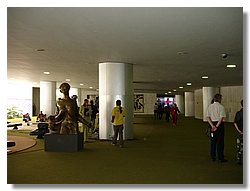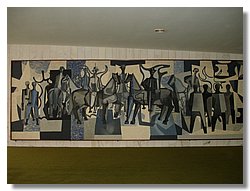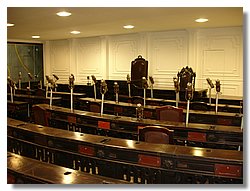Facts
Travel
Hotels
Restaurants
Business
Photos
|
The Brazilian Parliament
See also:
 Brasilia homepage Brasilia homepage
 Brasilia: Brazil political center Brasilia: Brazil political center
The Federal Legislative Power in Brazil is exercized by two chambers: the Federal Senate and the Chamber of Deputies. Members of the Senate are called Senadores (Senators) and members of the Chamber are called Deputados Federais (Federal Deputies).
The two hemi-spheres are the Plenaria of the Senate and the Federal Chamber.
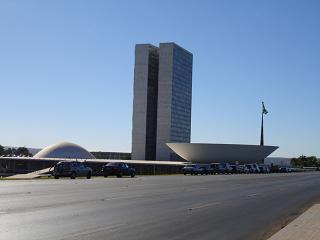 The hemi-shpere looking down is the Senate, and the other one is the Chamber. Why that? According to Niemayer, the Senate is by nature more conservative, whereas the Chamber is more opened to the popular clamor; so, the Senate was built more hermetic, and the Chamber more opened. Also, because the Senate and the Chamber have complementary functions (read further below), they were also shaped in a complementary way (each House could be stacked on top of the other).
The hemi-shpere looking down is the Senate, and the other one is the Chamber. Why that? According to Niemayer, the Senate is by nature more conservative, whereas the Chamber is more opened to the popular clamor; so, the Senate was built more hermetic, and the Chamber more opened. Also, because the Senate and the Chamber have complementary functions (read further below), they were also shaped in a complementary way (each House could be stacked on top of the other).
The two buildings in between the hemi-spheres are called Annex I and this is where part of the administrative staff of the Congress is located. These are the two tallest buildings in the Federal District; the Fire Department had to adapt their equipment to work at these buildings; two catwalks connect the buildings, in the 16th and 17th floors.
Notice also that there other three Annexes to the Congress; Annexes II and III are under the soil; Annex IV is a 13 floor building with a restaurant on the top floor, which affords a nice view of the Three Powers Square.
The Federal Deputies are in number proportional to the population of each State; there is a minimum and a maximum number of Deputies. The Senators represent the Brazilian State; regardless of area, population or economic power, each Brazilian State elects three Senators.
Read more about the political roles of the Brazilian Senate and of the Brazilian Federal Chamber.
Brazilians do not use the denominations lower and upper chamber. All Deputies and Senators are elected by popular vote. Deputies are elected for a term of four years, whereas Senators stay eight years in office.
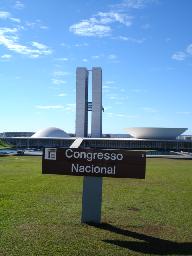 Both Deputies and Senators have powers to propose law drafts, which are first examined by the respective House; laws proposed by the President of Republic are sent first to the Chamber. Both Houses must approve independently the draft (meaning that one House refines what comes from the other), which must be eventually sanctioned by the President, before it becomes law.
Both Deputies and Senators have powers to propose law drafts, which are first examined by the respective House; laws proposed by the President of Republic are sent first to the Chamber. Both Houses must approve independently the draft (meaning that one House refines what comes from the other), which must be eventually sanctioned by the President, before it becomes law.
When referred to as an entitity, the chambers are called the Congresso Nacional (National Congress); the President of the Senate is also the President of the Congress. In a few specific situations (e.g., the appreciation of a veto to a law draft by the President), the Congresso is called to voting.
Visiting the Congress
There are guided tours (in Portuguese only) to the Congress, daily from Monday through Friday.
The tours usually include a visit to the Floors of both chambers. Usually, there are legislative sessions from Tuesday through Thursday, in the afternoons. Access to the offices of the Congressmen and Congresswomen are allowed, and it is common to come across Deputies and Senators in the corridors.
The tours starts in the lower floor, back entrance of the Congress. Read more about tours to the Senate and the Chamber.
A visitor walking along the corridors of the Brazilian Parliament will have the chance to see important artistic and historical pieces. These include sculptures by Alfredo Ceschiatti, paintings by Di Cavalcanti, a set of historic photographies which portray important moments of Brazilian History and a replica of the old Brazilian Senate, preserved from the times when Rio de Janeiro was still the capital.
|
|


 The hemi-shpere looking down is the Senate, and the other one is the Chamber. Why that? According to Niemayer, the Senate is by nature more conservative, whereas the Chamber is more opened to the popular clamor; so, the Senate was built more hermetic, and the Chamber more opened. Also, because the Senate and the Chamber have complementary functions (read further below), they were also shaped in a complementary way (each House could be stacked on top of the other).
The hemi-shpere looking down is the Senate, and the other one is the Chamber. Why that? According to Niemayer, the Senate is by nature more conservative, whereas the Chamber is more opened to the popular clamor; so, the Senate was built more hermetic, and the Chamber more opened. Also, because the Senate and the Chamber have complementary functions (read further below), they were also shaped in a complementary way (each House could be stacked on top of the other). Both Deputies and Senators have powers to propose law drafts, which are first examined by the respective House; laws proposed by the President of Republic are sent first to the Chamber. Both Houses must approve independently the draft (meaning that one House refines what comes from the other), which must be eventually sanctioned by the President, before it becomes law.
Both Deputies and Senators have powers to propose law drafts, which are first examined by the respective House; laws proposed by the President of Republic are sent first to the Chamber. Both Houses must approve independently the draft (meaning that one House refines what comes from the other), which must be eventually sanctioned by the President, before it becomes law.